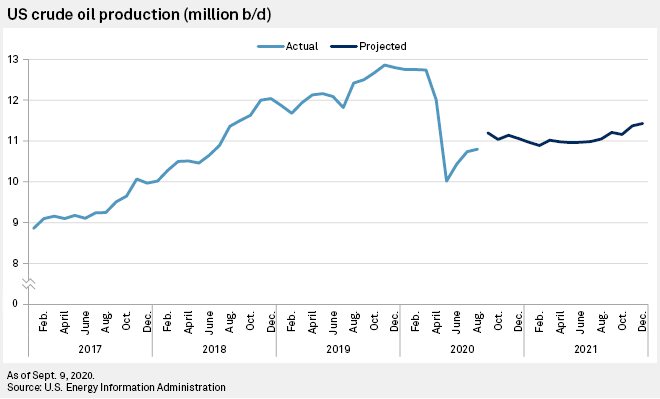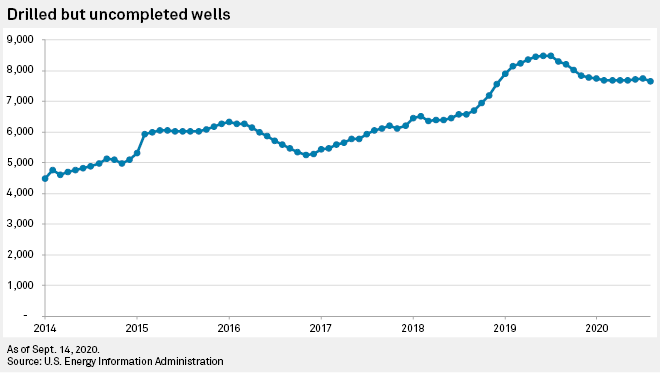U.S. oil producers continue to struggle from the fallout of the COVID-19 pandemic as crude prices continue to languish near $40 per barrel with little hope for a substantial or sustainable rally in the foreseeable future.
West Texas Intermediate crude oil was trading above $70/b in September 2018, and if WTI prices were to get within $10/b of that number anytime within the next 12 months, independent producers would have good reason to celebrate. The WTI prompt-month contract closed Sept. 23 at $39.93/b, or about 45% below where it was in late September 2018. With demand rocked by the COVID-19 crisis, prices have yet to rebound in spite of massive cuts in production by U.S. companies – and it is very hard to find anyone optimistic things will improve anytime soon.
"$45 is not an easy price to live at; $35 makes it really hard. It's going to be an ongoing challenge," said Duane Dickson, U.S. Oil, Gas & Chemicals sector leader for Deloitte LLP. "In the U.S., we're probably returning to normal [demand] levels 18 months from now."
However, the WTI futures curve suggests a more pessimistic view. Current futures contracts are trading below $45/b through 2023, and are only slightly better in March 2025. In its latest update, released Sept. 23, the Dallas Fed reported that two-thirds of 154 oil and gas executives polled said U.S. oil production has peaked, with only 34% disagreeing.
"I'm expecting $45 to $50, and probably closer to $45 seems more realistic," said Amarillo, Texas-based energy economist Karr Ingham when asked about his projection for WTI prices into 2021. "Here's hoping we get beyond COVID and things get closer to normal. But we're not moving towards that pre-COVID lifestyle very quickly at all right now."

Judging from comments in their second-quarter earnings calls, independent producers are not optimistic about higher prices coming anytime soon either. Their comments indicated a belief that the price slump would continue well into next year, and their approaches had changed accordingly. One producer after another discussed how they were capable of generating free cash flow at $40/b or below, a clear sign they were bracing for prolonged low prices.
"We have a plan for next year to maintain [projected fourth-quarter 2020 production] and generate free cash flow at $40 flat oil next year at $3.4 billion of capex," EOG Resources Inc. Chairman and CEO William Thomas said. During his second-quarter earnings call comments, Pioneer Natural Resources Co. President and CEO Scott Sheffield said he expected prices to average around $50/b for the several years, with some years being closer to $40/b and others closer to $60/b. Apache Corp. President and CEO John Christmann indicated his company was looking at $50/b as a starting point for 2021 but asserted the company would have flexibility to cut its budget if prices remain below that level.
"To the extent oil prices are sustained at or below $50 per barrel WTI, we do not anticipate a material change in our annual capital budget from the current rate of around $1 billion. For oil prices significantly below $50, capital spending is more likely to be reduced from the $1 billion mark," Christmann said.
Many oil industry veterans repeat the mantra that the only solution to low prices is low prices, or that cuts in supply will eventually force prices up. But supply was already slashed drastically in the first quarter and prices barely budged. Now, with more wells being brought back online in the second quarter, production is increasing in areas like the Permian Basin.
"Production in Texas and the U.S. has stopped declining and is increasing," Ingham said. "All you have to do is restart some wells and complete some [drilled but uncompleted wells] and it goes up."

In other words, not even low prices are stopping low prices. This price downturn, observers say, will only be rectified by an increase in demand. Increased gas usage by cars and a return to close to regular air travel will be the driver in an oil price recovery, but neither looks imminent.
"Signposts are miles driven and traffic patterns from cars and trucks. Also, the aerospace industry and their utilization. If those don't start to come back, then this is probably where we are for a while," Dickson said.
A resurgence in COVID-19 cases in other parts of the world has also contributed to a halt in the demand recovery, which IHS Markit estimated in early September had reached nearly 90% of pre-COVID levels.
"It looks like demand has stalled because of this COVID uncertainty. There's a lot of concern in Europe now," Ingham said.
In a Sept. 23 note to clients, analysts at Goldman Sachs said the market continues to lack confidence in short-term demand and is seeking clarity regarding post-election policy and longer-term oil demand growth.
"Longer-term demand also remains in focus," the analysts noted, pointing to a recent forecast from BP p.l.c. that indicates U.S. oil demand may have peaked in 2019. "We continue to assume demand growth, though at deceleration. However, we believe lower long lead time project spending and slower short-cycle shale growth will offset the deceleration in demand," the bank analysts wrote.
If prices do start to come back, there is a possibility they could surge in a hurry. In its September analysis of the oil markets, Morningstar estimated that a fairly low number of shale oil wells will be profitable even if prices push back over $50/b.
"According to conventional wisdom, the efficiency gains that producers have generated since the 2014 downturn have made it possible for shale firms to drill profitable wells, even when crude prices are very low. … On the contrary, we think only half of the wells drilled since the beginning of 2017 would be profitable today at $55/bbl," the firm said.

In a somewhat self-defeating prospect, a large number of executives told the Dallas Fed they believed the U.S. rig count would significantly increase before prices reached $55/b. Forty-three percent of those polled said they expected rig counts would increase substantially if WTI prices were in the $51/b to $55/b range, while 29% said they believed it would require prices between $56/b and $60/b.
"$60 oil is stimulative," Ingham said. "But I don't see anything approaching $60. I hope I'm wrong."
While oil companies would be happy to see $60/b oil return, there is a concern another prolonged dip in prices could be the death knell for a large number of independents.
"We looked at negative cash flows and technical insolvency and linked it to oil price and we went with $35," Dickson said. "At that price, upstream is not making money and it's not clear what the remedy is."



